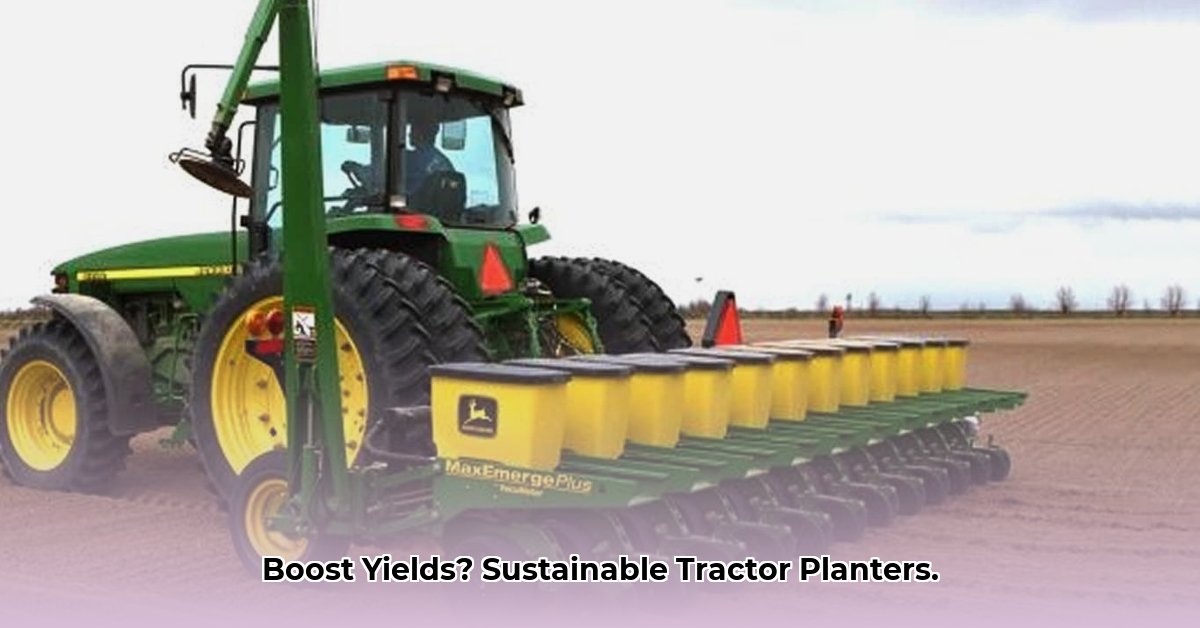
Tractor Planters: Precision Planting for Sustainable Farming and Higher Yields
Tractor planters have transformed agriculture, evolving from simple seed dispersal to a precise, data-driven approach that significantly increases yields while promoting environmental sustainability. This technological advancement presents both remarkable opportunities and considerable challenges. This review examines the current state of precision planting technology, analyzes its economic viability, explores future trends, and offers actionable recommendations for various stakeholders. For more information on tractor PTO types, check out this helpful resource: Tractor PTO Types.
Current Trends in Precision Planting Technology
Modern tractor planters integrate sophisticated technology, surpassing the capabilities of their predecessors. GPS-guided planting ensures consistent seed spacing, eliminating overlaps or gaps, resulting in uniform crop growth and yield optimization. This precision is further enhanced by variable rate technology (VRT), which adjusts seed and fertilizer application based on specific field needs, adapting to soil variations and maximizing resource utilization while minimizing waste and environmental impact. Advanced seed spacing mechanisms optimize plant density, maximizing yields without overcrowding. Leading manufacturers, such as John Deere, spearhead these innovations, continually improving efficiency and effectiveness. The integration of these technologies creates a system that understands and reacts to the unique needs of each section of the field. How can farmers further leverage precision planting to increase efficiency and reduce environmental impact?
Technical Specifications and Comparative Analysis of Tractor Planters
Selecting the appropriate planter hinges on the specific requirements of each farming operation. Small-scale operations have different needs compared to large-scale agricultural businesses. The following table outlines key differences:
| Feature | Small-Scale Planter | Large-Scale Planter | Considerations |
|---|---|---|---|
| Planting Capacity (acres/hour) | Low (20-40) | High (80-120+) | Field size and planting deadlines are crucial factors in capacity selection. |
| Planting Method | Mechanical, often simpler design | Air or mechanical, sophisticated systems | Air planters offer higher capacity but typically command a higher initial investment. |
| Initial Cost | Lower | Significantly higher | Financing options and projected return on investment are key considerations. |
| Maintenance | Relatively less complex | More complex, potentially higher costs | Downtime and ongoing maintenance expenses must be factored into the total cost. |
| Suitability | Smaller fields, diverse crop types | Large, uniform fields, specific crops | Crop diversity and soil variation influence planter suitability. |
Data availability for a comprehensive comparison across all planter types remains limited. Further research and field studies are necessary for a robust comparative analysis. This is an area of ongoing development and research.
Sustainability Aspects: Precision Planting's Environmental Impact
Precision planting is not merely about higher yields; it's a crucial element of sustainable agriculture. Precise application of fertilizers and pesticides minimizes environmental impact by ensuring only necessary amounts reach the plants. This reduces runoff, groundwater contamination, and overall waste. Optimized water usage conserves this vital resource, reducing water stress on crops. Consequently, reduced overlaps and improved seed placement lead to lower fuel consumption, minimizing a farmer's carbon footprint.
While precise quantification varies across contexts, the overall trend strongly indicates a more environmentally responsible farming approach. Ongoing research accurately measures the environmental benefits of precision planting techniques.
Economic Viability: The Costs and Returns of Precision Planting
The initial investment in precision planting, especially for large-scale operations, presents a significant financial hurdle. However, the potential for considerable long-term returns is equally substantial. Reduced input costs (fertilizer, pesticides) combined with higher yields quickly offset initial expenses. Smaller operations may consider shared equipment resources or leasing options to manage costs. A thorough cost-benefit analysis, encompassing yield gains, input savings, and planter lifespan, is essential. The long-term economic viability depends on diverse factors, including crop prices and market conditions. What further economic benefits could be realized through the adoption of precision planting technologies?
Challenges and Barriers to Adoption
Despite the many benefits, several challenges impede the wider adoption of precision planting. Access to funding, especially for smaller farms, remains a major roadblock. The complexity of the technology, particularly in data management, can be daunting. Comprehensive training programs and support networks are critical for successful implementation. Risks include equipment malfunctions, data security breaches, and the need for robust maintenance. A thorough risk assessment is essential for any adoption plan.
Future Directions: The Smart Farm of Tomorrow
The future of precision planting is promising. AI-driven systems analyze data from diverse sources, including soil sensors and weather forecasts, dynamically optimizing planting strategies. Autonomous tractors and robotic systems will further automate the process, potentially reducing labor costs and increasing efficiency. Advanced sensor technology provides real-time feedback on soil conditions, enabling immediate adjustments during planting. The potential extends to fully automated systems managing crop health and harvesting.
Regulatory Implications for Tractor Planters
Regulations concerning pesticide and fertilizer use, along with data privacy laws, significantly influence precision planting technology. Farmers and manufacturers must adhere to these regulations and anticipate future changes. Future regulations will likely emphasize sustainability and resource efficiency, potentially incentivizing precision technology adoption.
Actionable Recommendations for Stakeholders
To fully realize the benefits of precision planting, stakeholders must take decisive action:
- Farmers (Small-Scale): Explore government grants and cooperative equipment sharing to offset costs. Seek training and mentorship.
- Farmers (Large-Scale): Invest in comprehensive data management systems. Implement AI-driven tools for optimized strategies.
- Equipment Manufacturers: Develop affordable, user-friendly technology. Utilize sustainable materials in planter construction.
- Government Agencies: Provide funding and incentives for wider adoption. Invest in training programs to enhance farmer literacy.
- Research Institutions: Continue research on economic and environmental impacts. Develop user-friendly data management tools.
The transition to precision planting is not merely a trend; it's a critical step towards sustainable and efficient agriculture. By proactively addressing challenges and embracing opportunities, we can build a future where food production is both productive and environmentally sound.